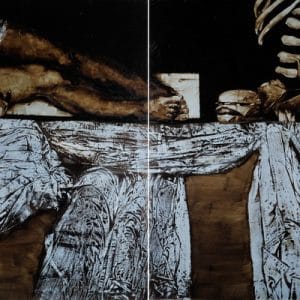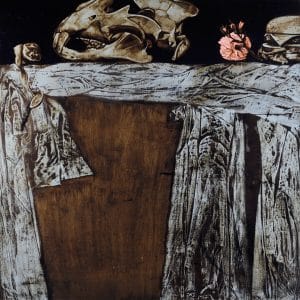Ilya Gapanov is a contemporary Russian painter known for his evocative and dynamic compositions that often blend elements of realism and abstraction. His style is characterized by bold brushstrokes, vibrant color palettes, and a keen attention to texture and movement, creating a sense of energy and emotional depth in his work. Gapanov draws inspiration from a variety of sources, including the natural landscapes of Russia and the bustling life of urban environments, including his home city of Kemerovo, a mining town near Novosibirsk.
Gapanov’s paintings frequently explore themes of human connection, the passage of time, and the interplay between nature and civilization, reflecting a deep engagement with both the external world and internal human experiences. Through his art, Gapanov aims to capture the fleeting beauty and complexity of life, inviting viewers to reflect on their own perceptions and emotions.
Gaponov was born in 1981. He attended the Kemerovo Art School and planned to study iconography further. However, in 2001, he went to the St. Petersburg State Academy of Art to study monumental painting. In 2004, he received a grant for further training at the National School of Fine Arts in Paris. After graduating in 2007, two schoolmates joined him in the creation of Unconquered, a non-profit organization that provides art workshops for young artists. Housed in a former missile factory, Unconquered provides 12 studios, a silk-screen printing workshop, and an exhibition hall. Gaponov has stayed busy as an artist as well, taking part in number of group and personal exhibitions in Russia since his return to his homeland .
Ilya Gaponov’s works are grandiose in size and meaning. “Altar of Thyatira,” an exhibition at St. Petersburg’s Name Gallery in 2012, was inspired by a passage in the Book of Revelation (2:18-29), in which Jesus challenges the church of Thyatira to stop following the false prophetess, Jezebel, who was a sexual seducer that lured the Christians to eat that which should be sacrificed. The exhibition is a thought-provoking collection of paintings. Gaponov paints vanitas, Latin for “vanity,” a baroque-style still life that is also known as memento mori, or “Remember Your Mortality.” This genre of art incorporates symbolism to remind the viewer of the impermanence of life. Skulls represent the inevitability of death; rotten fruit represents aging, and so on. Objects are often in disarray to symbolize the end of their usefulness.
Gaponov does not merely follow the rules of the genre. He incorporates modern elements into his pieces, such as McDonald’s hamburgers, a vacuum cleaner, a tea kettle, and assorted animals, including a shaved Chihuahua. He also adds the element of human figures, which is a rarity for the art form. In one painting, there is a plump baby, symbolizing the loss of innocence, cryptically lying next to a large rib-cage, which signifies death. In another painting, two feet nailed with holes (Jesus Christ) hang amidst a row of skulls. Other portraits have iconography in the background. Everything, from religion to sexuality, becomes ephemeral in his works.
“(His work) is about spirituality and morality or, rather, their absence in the world,” wrote Alexandra Rudryk, an art critic with Interview Magazine (Russia). “The muted, dark colors, dark gold, and epic themes slowly absorb the viewer’s attention. Here comes a state of torpor, to which is added something hostile.” The dark colors are no accident – to achieve them, Gaponov uses Kuzbass (coal-tar) varnish and bitumen varnish, a substance extracted from pit-mining (tar sands). One of the largest coal deposits in the world is in Kuzbass, a nickname for the Kuznetsk Basin in the Kemerovo region. These products are slowly becoming popular among contemporary artists. For Gaponov, they have an ecological symbolism for mining in Russia.
Gaponov is also currently exhibiting works at a gallery in London. One of Gaponov’s foremost collectors is Evgeny Lebedev, a Russian billionare who also owns the London Evening Standard and has been active in liberal political causes and pushing for transparency in the corportate governance of the businesses he invests in. At Gapanov’s London opening, Lebedev said “everything about Gaponov’s work speaks to his disillusionment with the excessive consumption of contemporary society.” This was considered a “seal of approval” by local magazines, but Gaponov still has a ways to go as an international artist.
Since 2013, Ilya Gapanov has continued to develop his artistic career with a series of significant works and major exhibitions. His pieces have been showcased in various prestigious galleries and international art fairs, highlighting his evolving style and thematic explorations. Notable exhibitions include his participation in the Moscow Biennale of Contemporary Art, where his dynamic compositions received critical acclaim for their vivid portrayal of urban and natural landscapes.
Gapanov’s work has also been featured in solo exhibitions, such as the one at the State Russian Museum in St. Petersburg, which presented a comprehensive overview of his recent creations. These exhibitions have often focused on themes such as the interplay between human emotion and the environment, showcasing his ability to merge realism with abstract elements.
In addition to gallery exhibitions, Gapanov has contributed to several public art projects and collaborative installations, further cementing his reputation as a versatile and innovative artist. His work continues to resonate with audiences, both in Russia and internationally, reflecting his deep engagement with contemporary artistic practices and cultural dialogues.















